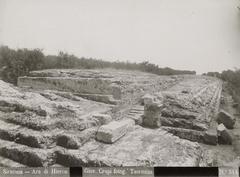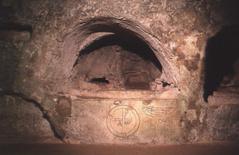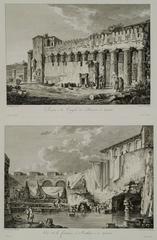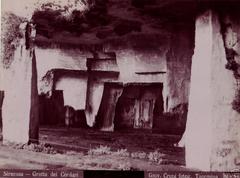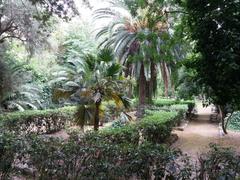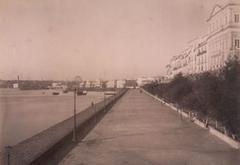Mediterranean Hippodrome Syracuse: Visiting Hours, Tickets & Travel Guide
Date: 15/06/2025
Introduction
Nestled in the storied city of Syracuse, Sicily, the Mediterranean Hippodrome (Ippodromo del Mediterraneo) offers a unique lens into both ancient traditions and contemporary sporting culture. While overshadowed by the famed Greek Theatre and Roman Amphitheatre, the hippodrome’s legacy bridges Syracuse’s Greek and Roman origins as a center for equestrian events with its modern role as an internationally renowned horse racing and motorsport venue. This comprehensive guide explores the historical significance, visitor information, events, and surrounding attractions of the Mediterranean Hippodrome, ensuring a rewarding experience for all travelers and history enthusiasts.
Historical Context: From Antiquity to Today
Ancient Origins
Founded in 734 BCE by Corinthian settlers, Syracuse quickly became one of the ancient Mediterranean’s powerhouses (Britannica; Italia.it). With prosperity came the construction of monumental public works, including grand theatres, temples, and likely a hippodrome. Hippodromes in Greek and Roman cities were central venues for chariot and horse racing, playing vital roles in religious festivals, civic celebrations, and the display of elite patronage (World Heritage Site; Alexander the Great.org).
Although the precise remains of Syracuse’s ancient hippodrome are not prominent, urban studies and ancient texts support its existence within the Neapolis district, where other major entertainment structures were built (Parco Archeologico Neapolis). Hippodromes typically featured elongated U-shaped arenas with a central spine (spina) for races and tiered seating for spectators.
Roman and Byzantine Evolution
Roman conquest in 212 BCE brought further development of public entertainment, with the Roman Amphitheatre becoming the epicenter for gladiatorial spectacles (The Crazy Tourist). However, chariot racing remained popular, and the hippodrome likely continued to function, possibly adapted to new tastes and architectural styles. During the Byzantine period, Syracuse maintained its provincial prominence, with public spaces adapting to Christian rituals while preserving the cultural memory of ancient venues (Wikipedia).
Archaeological Evidence
While large-scale remains of the ancient hippodrome are scant, the Neapolis Archaeological Park—home to the Greek Theatre and Roman Amphitheatre—contains large open spaces and substructures that suggest the presence of such a venue (World Heritage Site). Archaeological efforts have uncovered ancient roads, drainage, and foundations that may relate to the hippodrome, though centuries of urban change have obscured definitive traces.
The Modern Mediterranean Hippodrome
Construction and Development
The modern Ippodromo del Mediterraneo, inaugurated in 1995 near Cassibile, has evolved into a premier horse racing facility. Internationally recognized, the venue hosts prestigious events including the Mediterranean and Black Sea Jockeys’ and Drivers’ Championships (medunion.it). The complex spans approximately 55 hectares and offers state-of-the-art racing tracks, stables, and grandstands.
Motorsport Heritage
The hippodrome’s motorsport legacy dates to the 1950s, when its circuit became a key destination for racing fans, featuring a track over 5,000 meters long (puregprace.com). Though regular motorsport events diminished after 1969, the site remains an icon among enthusiasts, with new plans for revitalization under Australian ownership as of 2025.
Social and Cultural Significance
Chariot and horse racing were not only entertainment but also expressions of civic identity, religious devotion, and political rivalry. Victories in the hippodrome brought glory to athletes and their patrons, enhancing the city’s prestige (Britannica). Today, the hippodrome continues to foster community spirit by hosting international championships, local festivals, and educational events.
Visiting the Mediterranean Hippodrome: Practical Information
Location & Access
- Address: Cassibile, approximately 15 km south of Syracuse, easily accessible by car via the SS115 highway. GPS: 36.99989111627, 15.190072379127.
- Public Transport: Limited; taxis and private transfers from Syracuse and Cassibile are recommended (Enjoy Sicilia).
- Parking: Free and ample on-site parking for cars and buses.
Visiting Hours
- Neapolis Archaeological Park (including ancient hippodrome site):
- Summer (April–October): 9:00 AM – 7:00 PM
- Winter (November–March): 9:00 AM – 4:00 PM
- Closed or hours reduced on public holidays and during special events. Always verify on the official website (Parco Archeologico Neapolis).
- Modern Hippodrome (race days/special events):
- Open primarily on race days, typically late afternoon or evening. Guided tours by appointment.
Tickets and Pricing
- Archaeological Park:
- Adults: €10
- EU Citizens (18–25): €7
- Children under 18, Syracuse residents: Free
- Purchase online or at ticket office; guided tours and audio guides for an extra fee.
- Modern Hippodrome:
- Standard race day tickets are affordable, with discounts for children, seniors, and groups. Premium and VIP packages available. Advance booking is recommended for major events.
Accessibility
- Archaeological Park: Maintained paths provide partial accessibility; some uneven terrain.
- Modern Hippodrome: Facilities are designed for accessibility, with ramps, accessible restrooms, and support available upon request.
Facilities & Amenities
- Shaded grandstands, hospitality suites, and VIP lounges during key events.
- Food kiosks serving Sicilian specialties and beverages.
- Clean restrooms, family zones, and children’s activities on race days.
- On-site betting facilities and helpful staff for newcomers.
Visitor Tips
- Best Seasons: Spring and autumn for pleasant weather and fewer crowds.
- Dress Code: Smart-casual; hats and sunglasses for daytime, comfortable shoes.
- Photography: Permitted for personal use; professional use requires permission.
- Safety: Security checks at entrances; respectful conduct expected.
- COVID-19: Mask-wearing indoors and social distancing required. Check for updates.
Events & Activities
Major Annual Events
- Greek Theatre Festival (May–June): Classical drama performances in the Greek Theatre (Tourist Secrets).
- Horse Racing Championships: Mediterranean and Black Sea Jockeys’ and Drivers’ Finals (medunion.it).
- Historical Reenactments & Concerts: Summer events include gladiator shows and live music in the park (Enjoy Sicilia).
- Food and Wine Festivals: Regional culinary festivals in nearby towns.
- Music Festivals: Jazz and classical events in historic venues.
Guided Tours & Educational Experiences
- Archaeological Park: Multilingual guided tours (1.5–2 hours), educational workshops, and interactive activities for families and schools (Tourist Secrets; Rudderless Travel).
- Modern Hippodrome: Behind-the-scenes tours by appointment.
Self-Guided Exploration
- Informative panels in Italian and English.
- Ample space for walks, photography, sketching, and picnicking.
Nearby Attractions
- Greek Theatre of Syracuse: Renowned ancient theatre seating up to 16,000 (Tourist Secrets).
- Roman Amphitheatre: 3rd-century CE, well-preserved gladiatorial arena.
- Ear of Dionysius: Famous limestone cave with unique acoustics.
- Latomia del Paradiso & Grotta dei Cordari: Dramatic ancient quarries (Rudderless Travel).
- Ortigia Island: Historic core with markets, Baroque churches, seaside promenades.
- Temple of Apollo: Oldest Doric temple in Western Europe.
- Forte Vigliena: Seaside swimming and panoramic views.
- Castello Maniace: 13th-century fortress at Ortigia’s tip.
Seasonal and Travel Tips
- Best Time: June offers ideal weather (28°C/83°F); peak tourist season requires advance bookings (The Travel Folk).
- Transport: Walking, taxis, or limited buses; car rental recommended for flexibility.
- Dining: Local markets and trattorias offer authentic Sicilian fare.
- Accommodation: Range of boutique and modern hotels; book early during festivals.
- Preservation: Respect marked paths and avoid climbing on ruins.
Frequently Asked Questions (FAQ)
Q: What are the Mediterranean Hippodrome visiting hours?
A: Neapolis Archaeological Park is open 9:00 AM–7:00 PM (summer) and 9:00 AM–4:00 PM (winter). The modern hippodrome opens for events and by appointment.
Q: How much do tickets cost?
A: Adults €10, EU citizens (18–25) €7, free for children under 18 and local residents. Event pricing varies.
Q: Can I buy tickets online?
A: Yes, via the official Archaeological Park or hippodrome websites.
Q: Are guided tours available?
A: Yes, in multiple languages; advance booking recommended.
Q: Are the sites accessible?
A: Both offer accessible facilities, though some ancient areas may be challenging.
Q: What events should I not miss?
A: Greek Theatre Festival, Mediterranean horse racing championships, and seasonal concerts.
Q: What COVID-19 measures are in place?
A: Masks are required indoors; social distancing protocols are enforced.
Visuals and Media
For high-quality images, virtual tours, and interactive maps, visit the official Enjoy Sicilia Hippodrome page and the Parco Archeologico Neapolis website.
Conclusion and Visitor Recommendations
The Mediterranean Hippodrome embodies the dynamic intersection of Syracuse’s ancient legacy and vibrant present. Whether you seek historical immersion, thrilling horse races, or cultural festivals, the hippodrome and its surrounding landmarks offer a rich and varied experience. For a seamless visit, book tickets in advance, consider guided tours, and explore the city’s wealth of historical sites and authentic Sicilian cuisine. Stay updated on events and visitor information through official channels and travel apps like Audiala.
Sources and Further Reading
- Britannica: Syracuse, Italy
- Italia.it: Syracuse
- The Crazy Tourist: 15 Best Things to Do in Syracuse, Italy
- World Heritage Site: Syracuse
- Alexander the Great.org: Syracuse Settlement
- Parco Archeologico Neapolis: Official Site
- Puregprace.com: The Sale of the Hippodrome of Syracuse
- Medunion.it: Mediterranean Championships in Syracuse
- Traveling Italian: Syracuse Travel Guide
- Enjoy Sicilia: Mediterranean Hippodrome, Cassibile
- Rudderless Travel: 2 Days in Syracuse and Ortigia, Sicily
- Tourist Secrets: Why Syracuse Sicily is a History Lover’s Dream
- Secretplaces.com: Discovering Syracuse
- Wikipedia: Syracuse, Sicily
- Italy Magazine: Siracusa
- The Travel Folk: Italy in June
